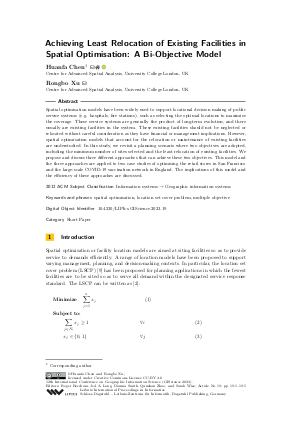Achieving Least Relocation of Existing Facilities in Spatial Optimisation: A Bi-Objective Model (Short Paper)
Authors
Huanfa Chen  ,
Rongbo Xu
,
Rongbo Xu
-
Part of:
Volume:
12th International Conference on Geographic Information Science (GIScience 2023)
Part of: Series: Leibniz International Proceedings in Informatics (LIPIcs)
Part of: Conference: International Conference on Geographic Information Science (GIScience) - License:
 Creative Commons Attribution 4.0 International license
Creative Commons Attribution 4.0 International license
- Publication Date: 2023-09-07
File

PDF
LIPIcs.GIScience.2023.19.pdf
- Filesize: 0.52 MB
- 5 pages
Document Identifiers
Subject Classification
ACM Subject Classification
- Information systems → Geographic information systems
Keywords
- spatial optimisation
- location set cover problem
- multiple objective
Metrics
- Access Statistics
-
Total Accesses (updated on a weekly basis)
0PDF Downloads0Metadata Views
Abstract
Spatial optimisation models have been widely used to support locational decision making of public service systems (e.g. hospitals, fire stations), such as selecting the optimal locations to maximise the coverage. These service systems are generally the product of long-term evolution, and there usually are existing facilities in the system. These existing facilities should not be neglected or relocated without careful consideration as they have financial or management implications. However, spatial optimisation models that account for the relocation or maintenance of existing facilities are understudied. In this study, we revisit a planning scenario where two objectives are adopted, including the minimum number of sites selected and the least relocation of existing facilities. We propose and discuss three different approaches that can achieve these two objectives. This model and the three approaches are applied to two case studies of optimising the retail stores in San Francisco and the large-scale COVID-19 vaccination network in England. The implications of this model and the efficiency of these approaches are discussed.
Cite As Get BibTex
Huanfa Chen and Rongbo Xu. Achieving Least Relocation of Existing Facilities in Spatial Optimisation: A Bi-Objective Model (Short Paper). In 12th International Conference on Geographic Information Science (GIScience 2023). Leibniz International Proceedings in Informatics (LIPIcs), Volume 277, pp. 19:1-19:5, Schloss Dagstuhl – Leibniz-Zentrum für Informatik (2023)
https://doi.org/10.4230/LIPIcs.GIScience.2023.19
BibTex
@InProceedings{chen_et_al:LIPIcs.GIScience.2023.19,
author = {Chen, Huanfa and Xu, Rongbo},
title = {{Achieving Least Relocation of Existing Facilities in Spatial Optimisation: A Bi-Objective Model}},
booktitle = {12th International Conference on Geographic Information Science (GIScience 2023)},
pages = {19:1--19:5},
series = {Leibniz International Proceedings in Informatics (LIPIcs)},
ISBN = {978-3-95977-288-4},
ISSN = {1868-8969},
year = {2023},
volume = {277},
editor = {Beecham, Roger and Long, Jed A. and Smith, Dianna and Zhao, Qunshan and Wise, Sarah},
publisher = {Schloss Dagstuhl -- Leibniz-Zentrum f{\"u}r Informatik},
address = {Dagstuhl, Germany},
URL = {https://drops.dagstuhl.de/entities/document/10.4230/LIPIcs.GIScience.2023.19},
URN = {urn:nbn:de:0030-drops-189144},
doi = {10.4230/LIPIcs.GIScience.2023.19},
annote = {Keywords: spatial optimisation, location set cover problem, multiple objective}
}
Author Details
References
- Huanfa Chen, Alan T. Murray, and Rui Jiang. Open-source approaches for location cover models: capabilities and efficiency. Journal of Geographical Systems, 23(3):361-380, April 2021. Publisher: Springer. URL: https://doi.org/10.1007/s10109-021-00350-w.
-
Richard L. Church and Alan Murray. Location covering models: History, applications and advancements. Springer, New York, 2018.

- Xin Feng, James D Gaboardi, Elijah Knaap, Sergio J Rey, and Ran Wei. Pysal/spopt. URL: https://doi.org/10.5281/zenodo.4444156.
- GNU Project. GLPK (GNU Linear Programming Kit), version 4.65, 2017. URL: http://www.gnu.org/software/glpk.
- Inc. Gurobi Optimization. Gurobi Optimizer Reference Manual, 2016. URL: http://www.gurobi.com.
-
Miettinen Kaisa. Nonlinear Multiobjective Optimization, volume 12 of International Series in Operations Research & Management Science. Kluwer Academic Publishers, Boston, USA, 1999.

- Alan T. Murray. Optimising the spatial location of urban fire stations. Fire Safety Journal, 62(PART A):64-71, November 2013. Publisher: Elsevier. URL: https://doi.org/10.1016/j.firesaf.2013.03.002.
- Donald R. Plane and Thomas E. Hendrick. Mathematical programming and the location of fire companies for the denver fire department. Operations Research, 25(4):563-578, August 1977. Publisher: INFORMS. URL: https://doi.org/10.1287/opre.25.4.563.
- Constantine Toregas, Ralph Swain, Charles ReVelle, and Lawrence Bergman. The location of emergency service facilities. Operations Research, 19(6):1363-1373, October 1971. Publisher: INFORMS. URL: https://doi.org/10.1287/opre.19.6.1363.
